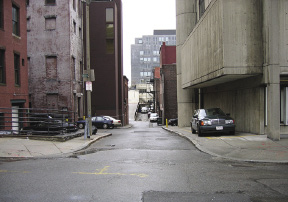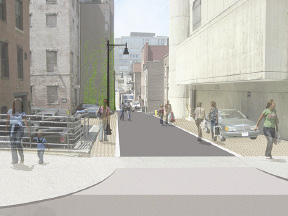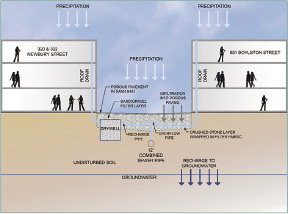Integrating sustainable site elements into an urban project requires creativity and collaboration to balance the sometimes competing needs of sustainable best management practices and urban sites. The Boston Architectural College (BAC) tackled this challenge head-on with their new Green Alley, part of their "Urban Sustainability Initiative." The project transformed an unsightly back alley, making access between the BAC buildings into a more pleasant and welcoming area.
The project is the first of its kind in the city of Boston, as it includes the installation of porous pavement and private geothermal wells in a public roadway. The result of collaboration between many private and public entities, the BAC-funded project also received grants and funding from the city of Boston Department of Environmental Protection, and the U.S. Department of Energy.
Using porous pavement solves problems that arise when building in Boston's Back Bay by raising the depleted groundwater levels that jeopardize building foundations, improving water quality in runoff to the Charles River, and removing stormwater flows from combined sanitary sewers. The porous pavement is designed to capture and infiltrate 90% of rainfall, thus removing stormwater flows from the combined sewer. The porous pavement is estimated to remove pollutants, including 70% of nitrogen, 66% of phosphorus, and 83% of sediment annually from stormwater flows.
The Green Alley includes eight geothermal standing column wells that will reduce energy costs for heating and cooling the two campus buildings. Water is circulated from the wells through the building mechanical systems and discharged back into the wells. The wells will result in a certain amount of excess water to maximize the system efficiency, which will be discharged back into the porous pavement system.
The BAC will monitor the installed systems to assess performance over time. Groundwater samples will be collected twice per year, and samples will be analyzed for pH and various pollutants. The BAC will also monitor the amount of rain water overflowing from the alley into the Boston storm sewer system, as well as groundwater levels in the alley. This information will be presented on a public display that students and faculty can then use for research and teaching purposes.
The BAC Green Alley project provides Boston with a model for integrating sustainability into tight urban spaces and is an example of how to transform pass-throughs into more desirable community spaces.
Team members included Nitsch Engineering as the civil engineer, Halvorson Design Partnership as the landscape architect, RDK Engineers as the mechanical/plumbing engineer, Wellspring Geothermal as the geothermal designer, ValleyCrest Landscape Companies as the contractor, and Linnean Solutions as the environmental performance consultant.
Chelsea Christenson, PE, CPSWQ, LEED AP BD+C, a civil engineering project manager at Nitsch Engineering and is a monthly contributing author for the New England Real Estate Journal's Green Building section.










